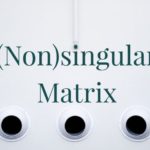Nilpotent Matrices and Non-Singularity of Such Matrices

Problem 146
Let $A$ be an $n \times n$ nilpotent matrix, that is, $A^m=O$ for some positive integer $m$, where $O$ is the $n \times n$ zero matrix.
Prove that $A$ is a singular matrix and also prove that $I-A, I+A$ are both nonsingular matrices, where $I$ is the $n\times n$ identity matrix.
Sponsored Links
Hint.
We give two proofs. The first one uses only some properties of the determinant of a matrix.
The second one uses the theory of eigenvalues.
We summarize several facts we will use below.
In proof 1.
- A matrix is nonsingular if and only if it is invertible.
- A matrix is nonsingular if and only if its determinant is nonzero.
- For two square matrices $A, B$, we have
\[\det(AB)=\det(A)\det(B).\]
In proof 2.
- Eigenvalues of $A$ are all scalars $\lambda$ such that the matrix $A-\lambda I$ is nonsingular.
Proof 1.
We use the fact that a matrix is nonsingular if and only if its determinant is nonzero.
Since the determinant is multiplicative, we have
\begin{align*}
0&=\det(O)=\det(A^m)=\det(A)^m.
\end{align*}
This implies that $\det(A)=0$, and hence the matrix $A$ is singular.
Next, we show that the matrix $I-A$ is nonsingular. Note that we have
\[ I=I-A^m=(I-A)(I+A+A^2+\cdots+A^{m-1}).\]
This implies that the matrix $I+A+A^2+\cdots+A^{m-1}$ is the inverse matrix of $I-A$.
Thus the matrix $I-A$ is invertible, and hence it is nonsingular.
Next, we show that the matrix $I+A$ is nonsingular.
Note that we have
\[I-(-A)^m=(I+A)(I-A+A^2-\cdots +(-1)^{m-1}A^{m-1}).\]
Since $(-A)^m=(-1)^mA^m=(-1)^mO=O$, we obtain
\[I=(I+A)(I-A+A^2-\cdots +(-1)^{m-1}A^{m-1})\]
and this implies that $I+A$ is invertible matrix with the inverse matrix
\[(I+A)^{-1}=I-A+A^2-\cdots +(-1)^{m-1}A^{m-1}.\]
Therefore, the matrix $I+A$ is nonsingular.
Proof 2.
In the second proof, we will use an eigenvalue technique.
Let $\lambda$ be an eigenvalue of the matrix $A$ and let $\mathbf{x}$ be the corresponding eigenvector. Namely, we have
\[A\mathbf{x}=\lambda \mathbf{x}.\]
Then we have
\begin{align*}
\mathbf{0}&=O\mathbf{x}=A^m\mathbf{x}\\
&=A^{m-1}A\mathbf{x}=A^{m-1}(\lambda \mathbf{x})=\cdots=\lambda^m\mathbf{x}.
\end{align*}
It follows that $\lambda=0$. Thus the only eigenvalue of $A$ is zero.
Recall that eigenvalues $\lambda$ are all scalars such that $A-\lambda I$ is a singular matrix.
Since $\lambda=0$ is an eigenvalue of $A$, the matrix $A=A-0I$ is singular.
Since $1$ is not an eigenvalue, we see that $A-I$ is nonsingular, and hence $I-A=-(A-I)$ is also nonsingular.
Similarly, since $-1$ is not an eigenvalue, we observe that $I+A=A+I$ is nonsingular.
Related Question.
A natural source of nilpotent matrices is the differentiation linear transformation of vector space of polynomials.
Check out the post “Differentiating Linear Transformation is Nilpotent” for problems and solutions about the nilpotency of the differentiation linear transformation.
Related Question.
Here is another problem about a nilpotent matrix.
Suppose that $A$ is an $n\times n$ nilpotent matrix and $B$ is an $n\times n$ invertible matrix.
Is the matrix $B-A$ invertible? If so, give a proof. Otherwise, give a counterexample.
See the post ↴
Is the Sum of a Nilpotent Matrix and an Invertible Matrix Invertible?
for the answer.
 Add to solve later
Add to solve later
Sponsored Links
















